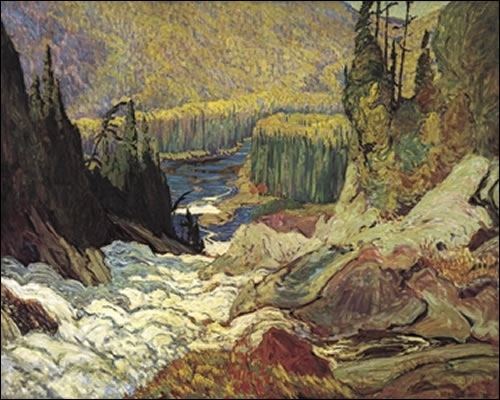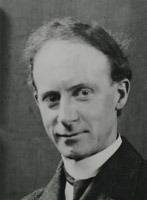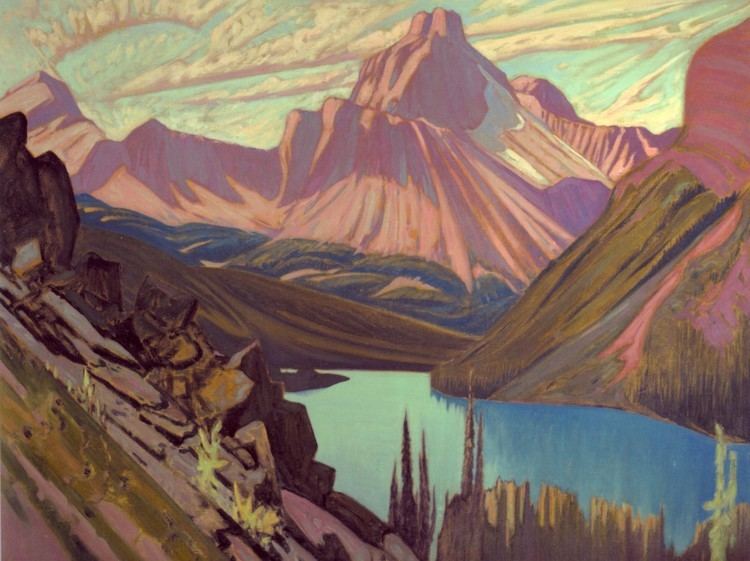Nationality English-Canadian Known for Painting | Name J. H. Children Thoreau MacDonald Role Artist | |
 | ||
Full Name James Edward Hervey MacDonald Notable work The Tangled GardenThe Solemn Land Artwork Dark Autumn, Rocky Mountains Similar People | ||
J E H MacDonald
James Edward Hervey MacDonald (May 12, 1873 – November 26, 1932), known as J. E. H. MacDonald, was a Canadian artist and one of the founders of the Group of Seven who initiated the first major Canadian national art movement. He was the father of illustrator Thoreau MacDonald.
Contents

J E H MacDonald
Early years

MacDonald was born on May 12, 1873 in Durham, England to an English mother and Canadian father, who was a cabinetmaker. In 1887 at the age of 14, he immigrated with his family to Hamilton, Ontario. That year he began his first training as an artist at the Hamilton Art School, where he studied under John Ireland and Arthur Heming. In 1889, they moved again to Toronto, where he studied commercial art and became active in the Toronto Art Student League. He continued his training at the Central Ontario School of Art and Design, where he studied with George Agnew Reid and William Cruikshank.

In 1895, MacDonald took a position as a commercial designer at Grip Ltd, an important commercial art firm, where he further developed his design skills. In the coming years, he encouraged his colleagues—including future artist Tom Thomson—to develop their skills as painters. In 1899, MacDonald married Joan Lavis, and two years later they had a son, Thoreau. MacDonald worked as a designer at Grip Ltd.until 1903, then at Carlton Studio in London from 1903 to 1907, and returned to Grip Ltd.in 1907. Whilst at Carlton, he worked with Norman Mills Price, William Tracy Wallace and Albert Angus Turbayne.
Early career as an artist

In 1911, MacDonald resigned his designer position at Grip Ltd and moved with his wife and child to Thornhill, Ontario to pursue a career as a landscape artist. To supplement his income, he worked occasionally as a freelance designer until 1921. After developing his own unique style to the genre, he organized a show of his work at the Arts and Letters Club of Toronto in November 1911. Fellow artist Lawren Harris—a member of the Royal Canadian Academy of Arts—was so impressed with MacDonald's work that he asked if they could work together. Harris encouraged MacDonald to continue painting and show his work whenever possible. The following year they organized their first joint exhibition. In 1912, MacDonald was widely recognized for his contributions to an exhibition at the Ontario Society of Artists.
In January 1913, MacDonald and Harris travelled to the Albright Art Gallery in Buffalo, New York, where they attended an exhibit of Scandinavian Impressionist landscape paintings. The two artists felt that the uninhibited approach to the northern Scandinavian wilderness could be adopted by Canadian painters to create on canvas a unique Canadian form of landscape art. Later that year, commercial artists based in Toronto began to show interest in the potential of original Canadian expression; these artists began to congregate around MacDonald and Harris. In the spring of 1913, MacDonald wrote to A. Y. Jackson, inviting him to come to Toronto, which he did in May.
In March 1916, MacDonald exhibited The Tangled Garden at the Ottawa Society of Artists. Though derided by art critics of the day, it was a fairly conventional post-impressionistic painting of sunflowers—one that has much in common with Van Gogh's treatment of the subject from nearly forty years before, but which Canadian critics rejected. Accustomed to the smooth blending and muted tones of Canadian academic art in the style of the Canadian Art Club, the critics were taken aback by the brightness and intensity of the colours. The art critic for the Toronto Daily Star called it "an incoherent mass of color". Hostile art critics thereafter singled out MacDonald for attacks in the press.
In the autumn of 1918, MacDonald, Harris, and other artists interested in their new Canadian approach to painting travelled to the Algoma district north of Lake Superior in a specially outfitted Algoma Central Railway car that functioned as a mobile artist studio. The group would hitch their car to trains travelling through the area, and when they found a scenic location, they would unhitch and spend time exploring and painting the wilderness. MacDonald would return to Algoma with his colleagues for the next several autumns. These trips would produce some of his most acclaimed paintings, including Mist Fantasy, Sand River, Algoma (1920) and The Solemn Land (1921).
Group of Seven
In 1920, MacDonald co-founded the Group of Seven, which dedicated itself to promoting a distinct Canadian art developed through direct contact with the Canadian landscape. The other founding members were Frederick Varley, A. Y. Jackson, Lawren Harris, Frank Johnston, Arthur Lismer, and Franklin Carmichael. MacDonald had worked with Lismer, Varley, Johnston, and Carmichael at the design firm Grip Ltd. in Toronto. Together they initiated the first major Canadian national art movement, producing paintings directly inspired by the Canadian landscape.
Every summer beginning in 1924, MacDonald travelled to the Canadian Rockies to paint the mountainous landscapes that dominated his later work. By this time he had become somewhat alienated from the rest of the Group of Seven, as many of the younger members were beginning to paint in a more abstract manner.
Later years
From 1928 until his death MacDonald served as the Principal of the Ontario College of Art, and he painted with less frequency and less consistent success.
Today, MacDonald is viewed with general admiration for his art, with one writer commenting, "no Canadian landscape painter possessed a richer command of colour and pigment than J. E. H. MacDonald ... His brushwork is at once disciplined and vigorous. His best on-the-spot sketches possess an intensity and freshness of execution not dissimilar from Van Gogh." His former home and 4-acre (16,000 m2) garden in Vaughan, Ontario have been restored. Owned by the City of Vaughan, they are open to the public.
MacDonald suffered a stroke in 1931, and spent the following summer recovering in Barbados. He died in Toronto on November 26, 1932 at the age of 59. He was buried at Prospect Cemetery in Toronto.
Legacy
On 8 June 1973 Canada Post issued 'J.E.H. MacDonald, painter, 1873-1932' designed by William Rueter based on MacDonald's "Mist Fantasy, Northland" (1922) in the Art Gallery of Ontario, Toronto. The 15¢ stamps were printed by Ashton-Potter Limited.
